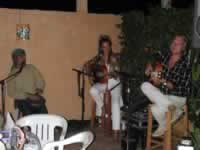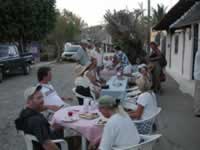
Volume XI - Mexico, Central Pacific Coast
 After the
excesses of Zihuatenejo, the Two Captains lay low in the dining
out department for the next month or so as
we picked our way north along the coast. Dining out options returned
to the familiar choices of the beachside palapa: ceviche – which
became minced progressively smaller and smaller as we moved north,
deep-fried pargo (snapper), with the occasional grilled dorado, shrimp
or octopus thrown in. In other words, there is a strong culinary
thread among all the Spanish-speaking coastal areas from Venezuela
to Panama, Ecuador to Mexico. This doesn’t mean it wasn’t
good, just nothing distinctive. After the
excesses of Zihuatenejo, the Two Captains lay low in the dining
out department for the next month or so as
we picked our way north along the coast. Dining out options returned
to the familiar choices of the beachside palapa: ceviche – which
became minced progressively smaller and smaller as we moved north,
deep-fried pargo (snapper), with the occasional grilled dorado, shrimp
or octopus thrown in. In other words, there is a strong culinary
thread among all the Spanish-speaking coastal areas from Venezuela
to Panama, Ecuador to Mexico. This doesn’t mean it wasn’t
good, just nothing distinctive.
Things changed pretty radically when we rounded Cabo Corrientes
into Banderas Bay. During the six weeks we spent in the area we ate
out a lot, thanks to the critical social mass of a whole bunch of
cruisers in one place coupled with a brief flow of visitors from
the States. Still, for all the eating out we did in the Puerto Vallarta
area (and all the $ spent!), there were very few evenings to be excited
about.
The first was Papacito’s in La Cruz de Huanacaxtle. Here we
were lucky enough to get reservations for the last show of Latchko & the
Gipsies, a passionate musical trio from Europe. Situated in a garden
courtyard, the music flickered like fire against the stucco walls
in front of tables packed with diners enjoying the startlingly continental
cuisine. I splurged on something completely non-Mexican with grilled
salmon and a Caesar salad. Well prepared, it was sheer heaven.
But several blocks away
we found the dining experience to which we returned over and over,
specifically on Saturday nights. Jorgé’s.
Mmm. The only things on the menu were beef tacos and beef quesadillas,
with flour or corn tortillas to choose between, a relish tray of
radishes and roasted peppers (hot!), and, to drink, the traditional
beverages of horchata (like a liquified rice pudding) or jamaica
(a cranberry-red brew made from hibiscus flowers!) Jorgé’s
was a family run operation – two nights a week only – with
the sons returning from medical school to hustle platefuls of food
to grateful diners who sit at tables along the curb! We would go
back to Puerto Vallarta just to go to Jorgé’s.
At La Cruz we were still in anchorage mode, but once we moved into
Paradise Village Marina, things shifted to an all-out resort mentality.
Because cruisers in the marina are technically guests at the resort,
we had the dangerous luxury of being able to charge drinks or meals
to our slip. One could go to a different fiesta buffet every night,
do Sunday brunch, check out the several sit down restaurants or just
order drinks and snacks on the beach or around the pool! This last
was our pitfall. Nothing like having a white-suited waiter bring
you an icy cold beer poolside, especially during 2 for 1 Happy Hour!
Fortunately, because of
our revised eating habits, the all-you-can-eat buffets did not
tempt the Two Captains. However our social group,
headed up by the very congenial Ed Marrill of our sistership Siesta,
made several mass outings. The most memorable was to Club Havana
(I think it is called) down on the Malecon. Ed and his wife Daisy,
both Cuban born, organized this dinner which I think had more than
14 boats involved, and it was very much as though Ed was our personal
host. We might have been in Havana itself, Ed was so keen to have
us all try and enjoy the tastes of his home country. The hit for
me was a totally new rum drink called a “Mojito”.
Recipe
for Mojito : Juice
of ½ lime, 1 tsp. Sugar, crushed
ice, 2 ounces white rum, splash of club soda, and 1 or 2 sprigs of
fresh mint! Talk about refreshing!
The only other two restaurants
we really enjoyed in PV, were Bernardo’s
and El Repollo Rojo (The Red Cabbage). Bernardo’s was one of
a smattering of independent restaurants on the strip of beach just
north of our marina known as Nuevo Vallarta, and with its Nouveau
French Caribbean cuisine pleased us (twice) with grilled tuna and
a memorable curried shrimp.
El Repollo Rojo was way
back in the hills and required a cab driver who knew where it was
to get there! This small nook of a place was
decorated in tribute to Mexico’s cherished yet unconventional
artists Diego Rivera and Frida Kahlo (about whom the recent move
was made) and its cuisine was dedicated to fine Mexican dishes. I
was able to have here – in May – the very unusual Chiles
en Nogada (poblano chilis stuffed with meat picadillo served chilled
with a sweet creamy walnut sauce topped with pomegranate seeds!)
which is a seasonal specialty from Puebla in July, August and September.
Independence Day in Mexico is September 16, and the colors of this
dish reflect the red, white and green of the Mexican Flag.
Here is a recipe given to me (in Spanish!) for Chiles en Nogada
by a restaurateur in Puebla. I have done my best to translate and
make logical substitutions!!
Chiles En Nogada (Serves 8)
Nogada (Walnut Cream) Sauce:
100 walnut halves
½
bolillo (a bolillo is a white roll) soaked in ½ cup milk
½ cup cream cheese
1/8 cup dry sherry, or to taste
Sugar to taste
Heavy cream, as necessary
Chopped fresh Parsley, for garnish
1 cup Pomeganate seeds, for garnish
Puree nuts, bread and
milk in a blender. Strain puree through a strainer, discarding
any skins that don’t pass through. Return
to blender and add cream cheese, sherry, sugar and sweet cream as
needed, and blend until smooth.
The Chiles:
16 fresh Poblano or Anaheim chiles
Outside of Mexico it is not easy to find Poblano chiles, but California
Anaheim chiles will do. I have even seen a recipe using canned whole
chiles, although I would think that would have a very different taste.
There is, however, a lot more work with fresh chiles, since they
must be peeled. There are two ways to do this. You can roast them
over a burner until the skin blackens and blisters, and then put
them in a plastic or paper bag to cool. Or you can achieve the same
thing by frying the chiles in oil instead of roasting them. The blistering
effect is more even, and there are no calories added as the chiles
are to be peeled!This trick I learned in a cooking class by Ileana,
chef at El Naranjo in Oaxaca City. (to be featured in a future Update.) Peel cooled chiles. Carefully slit one side and remove the seeds
and the pith, leaving stem ends intact. Then cook the chiles in boiling
water for about five minutes until tender. Allow to cool again.
Picadillo (Filling)
2 pounds ground or diced pork
Salt & Pepper to taste
1 onion
2 cloves of garlic
1 bay leaf
½ onion, minced
½ cup butter
4 cups tomatoes, crushed and strained
1 apple, peeled and finely diced
1 banana, finely diced
1 pear, finely diced
1 tablespoon sugar
½ cup pine nuts
½ cup slivered almonds Simmer pork in water with salt, pepper, onion, garlic and bay leaf
until cooked. Strain.
In another pan, sauté the minced onion in butter. Add the
crushed tomatoes (the Mexican way would be to puree fresh plum tomatoes
in the blender), and sauté for two minutes. Add the diced
fruit and sugar and season with salt & pepper. Stir in the pork
and the nuts. Cook until all liquid is evaporated, and allow mixture
to cool. Stuff picadillo into cooled chiles, and chill.
To Serve:
Arrange stuffed, cooled chiles on individual plates or on your chilled
serving platter. Spoon the nogada sauce over the chiles, and the
scatter the chopped parsley and pomegranate seeds over the top.
|